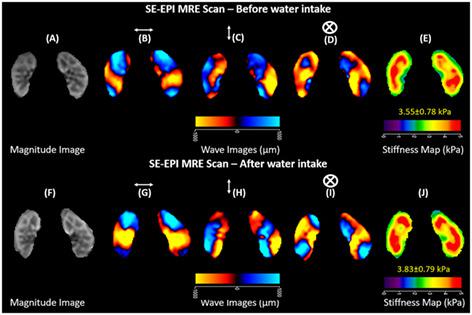当前位置:
X-MOL 学术
›
NMR Biomed.
›
论文详情
Our official English website, www.x-mol.net, welcomes your
feedback! (Note: you will need to create a separate account there.)
Magnetic resonance elastography-derived stiffness of the kidneys and its correlation with water perfusion.
NMR in Biomedicine ( IF 2.7 ) Pub Date : 2019-12-30 , DOI: 10.1002/nbm.4237 Deep Gandhi 1, 2 , Prateek Kalra 2 , Brian Raterman 2 , Xiaokui Mo 3 , Huiming Dong 1, 2 , Arunark Kolipaka 1, 2
NMR in Biomedicine ( IF 2.7 ) Pub Date : 2019-12-30 , DOI: 10.1002/nbm.4237 Deep Gandhi 1, 2 , Prateek Kalra 2 , Brian Raterman 2 , Xiaokui Mo 3 , Huiming Dong 1, 2 , Arunark Kolipaka 1, 2
Affiliation

|
Stiffness plays an important role in diagnosing renal fibrosis. However, kidney stiffness is altered by perfusion changes in many kidney diseases. Therefore, the aim of the current study is to determine the correlation of kidney stiffness with water intake. We hypothesize that kidney stiffness will increase with 1 L of water intake due to increased water perfusion to the kidneys. Additionally, stiffness of the kidneys will correlate with apparent diffusion coefficient (ADC) and fractional anisotropy (FA) values before and after water intake. A 3 T MRI scanner was used to perform magnetic resonance elastography and diffusion tensor imaging of the kidneys on 24 healthy subjects (age range: 22-66 years) before and after water intake of 1 L. A 3D T1-weighted bladder scan was also performed to measure bladder volume before and after water intake. A paired t-test was performed to evaluate the effect of water intake on the stiffness of kidneys, in addition to bladder volume. A Spearman correlation test was performed to determine the association between stiffness, bladder volume, ADC and FA values of both kidneys before and after water intake. The results show a significant increase in stiffness in different regions of the kidney (ie, percentage increase ranged from 3.6% to 7.5%) and bladder volume after water intake (all P < 0.05). A moderate significant negative correlation was observed between change in kidney stiffness and bladder volume (concordance correlation coefficient = -0.468, P < 0.05). No significant correlation was observed between stiffness and ADC or FA values before and after water intake in both kidneys (P > 0.05). Water intake caused a significant increase in the stiffness of the kidneys. The negative correlation between the change in kidney stiffness and bladder volume, before and after water intake, indicates higher perfusion pressure in the kidneys, leading to increased stiffness.
中文翻译:

磁共振弹性成像得出的肾脏硬度及其与水灌注的关系。
刚度在诊断肾纤维化中起重要作用。但是,许多肾脏疾病的灌注变化会改变肾脏的硬度。因此,本研究的目的是确定肾脏僵硬程度与摄水量之间的关系。我们假设,由于对肾脏的灌注增加,肾脏僵硬度将随着1 L的进水而增加。另外,肾脏的刚度将与进水前后的视在扩散系数(ADC)和分数各向异性(FA)值相关。在摄取1 L水之前和之后,使用3 T MRI扫描仪对24位健康受试者(年龄范围:22-66岁)进行肾脏的磁共振弹性成像和弥散张量成像。还进行了3D T1加权膀胱扫描在进水前后测量膀胱体积。进行了配对t检验,以评估除膀胱体积外,摄水量对肾脏僵硬的影响。进行了Spearman相关性测试,以确定饮水前后两个肾脏的硬度,膀胱体积,ADC和FA值之间的关联。结果显示,饮水后,肾脏不同区域的僵硬度显着增加(即百分比增加范围为3.6%至7.5%)和膀胱体积显着增加(所有P <0.05)。肾硬度和膀胱容量之间存在中等程度的显着负相关(一致性系数= -0.468,P <0.05)。在两个肾脏中,进水前后的刚度与ADC或FA值之间均未发现显着相关性(P> 0.05)。饮水导致肾脏僵硬的显着增加。饮水前后,肾脏僵硬程度与膀胱体积的变化呈负相关,表明肾脏的灌注压更高,从而导致僵硬程度增加。
更新日期:2020-03-09
中文翻译:

磁共振弹性成像得出的肾脏硬度及其与水灌注的关系。
刚度在诊断肾纤维化中起重要作用。但是,许多肾脏疾病的灌注变化会改变肾脏的硬度。因此,本研究的目的是确定肾脏僵硬程度与摄水量之间的关系。我们假设,由于对肾脏的灌注增加,肾脏僵硬度将随着1 L的进水而增加。另外,肾脏的刚度将与进水前后的视在扩散系数(ADC)和分数各向异性(FA)值相关。在摄取1 L水之前和之后,使用3 T MRI扫描仪对24位健康受试者(年龄范围:22-66岁)进行肾脏的磁共振弹性成像和弥散张量成像。还进行了3D T1加权膀胱扫描在进水前后测量膀胱体积。进行了配对t检验,以评估除膀胱体积外,摄水量对肾脏僵硬的影响。进行了Spearman相关性测试,以确定饮水前后两个肾脏的硬度,膀胱体积,ADC和FA值之间的关联。结果显示,饮水后,肾脏不同区域的僵硬度显着增加(即百分比增加范围为3.6%至7.5%)和膀胱体积显着增加(所有P <0.05)。肾硬度和膀胱容量之间存在中等程度的显着负相关(一致性系数= -0.468,P <0.05)。在两个肾脏中,进水前后的刚度与ADC或FA值之间均未发现显着相关性(P> 0.05)。饮水导致肾脏僵硬的显着增加。饮水前后,肾脏僵硬程度与膀胱体积的变化呈负相关,表明肾脏的灌注压更高,从而导致僵硬程度增加。











































 京公网安备 11010802027423号
京公网安备 11010802027423号